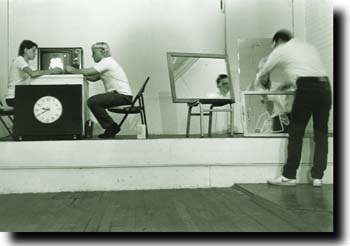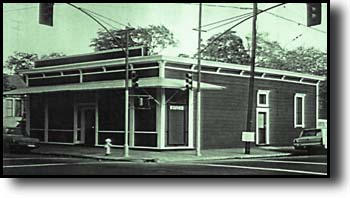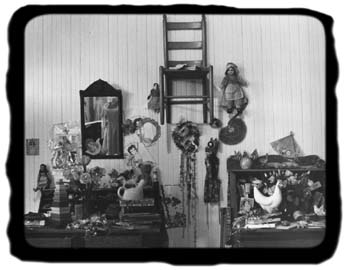In the WORKS/SJ
The Art of Performance and the Performance of Art: Over the years, WORKS has hosted both art shows and experimental performance pieces. Pictured are Lisa Venuti, Phil Tiger and James Poppitz of "Fashion Moda" in a 1984 performance at the gallery.
San Jose's peripatetic WORKS/San Jose gallery celebrates 20 years of cutting-edge art and performance with a move to a new home
By Ann Elliott Sherman
LIVING UP to its name far more than anyone, including its founders, ever anticipated, the WORKS/San Jose gallery has survived labor-intensive birth, an anarchic adolescence, cyclical financial crises and multiple relocations over its 20-year history to become that most paradoxical of things: a venerable, alternative nonprofit arts organization.
WORKS, which is celebrating two decades of showcasing experimental art with a move to a large new space, has become a permanent, if floating, fixture in the Santa Clara Valley's art scene. As a gallery and performance space owned and overseen by the artists themselves, it offers a useful counterbalance to private galleries and public museums.
An offshoot of the short-lived MERZ gallery and Wordworks started by then San Jose State University gallery director Jessica Jacobs, what set WORKS apart was its grassroots approach to running a gallery. As SJSU art professor Tony May explains it, after Jacobs lost her space in the spring of 1977, she convened a series of weekly meetings aimed at creating a more viable alternative organization. The new gallery, she thought, would best succeed if the assembled artists named her the executive director.
Jacobs, however, hadn't anticipated an unintended side effect of her planning process. "The group, by that point, decided that they liked this chaotic, democratic kind of process too much," recalls May. "They didn't really want a director."
Incorporating for nonprofit status, the group elected Jacobs to preside over the board of directors, but the philosophical differences led her to resign. (Jacobs relocated her Wordworks gallery to South First Street, where it eventually metamorphosed into the more traditionally structured San Jose Institute of Contemporary Art.)
May, often referred to as the Godfather of WORKS, stepped into the role of board president, and the group moved into a former meat market on the corner of Vine and Auzerais streets in downtown San Jose. Board members and friends renovated the site during lunch hours and after work. The walk-in freezer was converted into an office, walls were built, and metal plates were hammered over the ruts and valleys of a warped wood floor.
WORKS readies for move back to downtown San Jose.
OPENING IN October 1977, WORKS leapt into the void left by more conservative venues. Its eclectic programming reflected the varied interests of its independent, three-person art-selection committees drawn from the community: the wood and found-object (including road kill) constructions of Robert Kinmont, paired with traditional Japanese wood joinery; Laurie Anderson tapes and photographs; concerts of jazz, new music and a gamelan; poetry, modern dance and other performance art.
As Jan Rindfleisch, now the director of the Euphrat Museum at De Anza College, remembers, the "really crude but nice" gallery allowed for novel installations like the farmhouse, complete with live chicken, built by current Fremont High School art instructor Bill Rushdon. That July 1978 installation was accompanied by the first Bay Area show of Sam Hernandez' sculptures after he returned from teaching at East Texas State University to take a post at Santa Clara University.
"San Jose was a relatively unknown area," Hernandez says, and "WORKS offered a venue that even then was credible enough that a curator at the Berkeley Art Museum came down, and I ended up having a show as a result."
In fact, the roster of early WORKS board members and associates reads like a current who's who in South Bay arts institutions. SJSU's Associate Dean of Arts and Humanities Steve French and printmaking department chair Erin Goodwin Guerrero; Genesis Sanctuary for the Arts founder Ruth Tunstall Grant; Triton Museum director George Rivera; the de Saisset Museum's Rebecca Schapp, Anna Koster and Fred Shepard; and former San Jose Museum of Art director Albert Dixon all contributed their energies to the fledgling gallery.
By 1983, a new cadre of artists stepped up to run the gallery when the founders ran into what May terms "typical volunteer group burnout."
Advocates of the punk aesthetic, the young Turks ran a Wednesday music showcase known as the 3-D Cafe under the direction of local legend Phil Tiger, a kind of rent party used to keep WORKS afloat when redevelopment plans threatened to oust the gallery from its funky home. Once the order to vacate came down in summer of 1984, the gallery held a demolition party, driving a car into the building and improvising assemblages of wreckage and spray paint.
Headed by Michael Selic, the WORKS' board found a supportive landlord in the owner of the Leticia Building on South First Street. "We were there when they were putting in light rail," Selic recounts. "We did some really weird stuff--garage band nights with art on the walls."
The alternative gallery managed to survive repeated financial crises and a healthy amount of turnover on the board. But the anarchy took its toll. May confesses, "There were years when I was not terribly happy to admit that I had been there, when it developed a reputation for being a place you wouldn't find open during their published hours because the [gallery] sitter never showed up that day."
The writing was literally on the wall in 1990 when the Leticia Building was tagged by the city as a "potentially unsafe structure," precipitating another move. WORKS settled for a warehouse in Japantown. Again the board members rolled up their sleeves to convert the space into a gallery. Jack Toolin, a recent board president and current performance-art coordinator, had just arrived in San Jose to attend SJSU's MFA program and was drawn in by the organization's democratic ethic.
"I go down there, and there's the board throwing hammers around, building new walls for the space. That just appealed to me right off the bat," Toolin says. Soon he was invited to serve on the art-selection committee.
EVEN WITH donations of labor and materials, moving to the Jackson Street address brought a significant rent increase that required WORKS to get its business affairs in order. The six-month tenure of the art selection committee also had to be adapted. Toolin explains, "We now put out a call for curatorial proposals. ... Instead of being on a committee for six months, their show might happen in a year. The principle is still there that people not affiliated with the gallery will come with fresh ideas, so that WORKS doesn't look the same every exhibition you see."
Amen to that notion of change, which goes far beyond slapping a new shade of paint on a different configuration of temporary walls. Even as the space demonstrates an increasing professionalism in both its administration and installation, a regular visitor can never be quite sure just what's in store this time:
Perhaps a weird, crawl-in concrete hive wired to alter the natural and digitally manipulated soundscore, including live performance by the hidden composer, in response to your movements. Or a chance to witness performance art that's excruciating, fascinating and/or sublime. The gallery's willingness to take a chance has as much to do with making San Jose feel like a world-class city as any new sports franchise.
WORKS' themed exhibitions generally go beyond the tamer sort focusing on a particular medium or genre. Exploring a guest curator's idea or issues of concern, these shows focus on art as communication, rather than a vehicle for individual recognition, even while they do afford opportunities to expand or even acquire a resumé.
Such themed exhibits have ranged from personal-as-political topics of masculinity and women's body images and health issues to explorations of ethnic identity and philosophical musings on individual versus collective good. In every case, the artists' freedom to play with the exhibition space, to bare all in rawly emotional terms and to hone a conceptual framework has been abundantly apparent.
Whether it's fun with an edge, as in K.C. Rosenberg's billboard broadcasting the caffeine-and-nicotine-enhanced fury of a spurned female driving all night with hell hounds of love on her tail or Constance Harris' invitation to pound a copper name tag, going to WORKS can be far more involving than just filing past another show.
On more than one occasion, it has caused me to confront my own mortality, reexamine opinions or figure out why a work gets to me at a deeply disturbing level.
Multiple Media: Maggie Brosnan's "Alter" installation, from the 1981 show "Our Creative Link: Three Generations of Women's Art," demonstrates the gallery's commitment to nontraditional displays.
OTHERS WHO look at art for a living also see WORKS as a welcome respite from the usual gallery grind. Always busy preparing a publication or curating another exhibition herself, Rindfleisch asserts, "It takes a lot to get me out to see a show, but I get pulled to go there."
"They have the biggest flops and the most interesting things at the same time. They go out on the limb more," Koster adds.
Many of WORKS' board members in recent years have come out of SJSU's rigorous art training, with expectations for the exhibitions to demonstrate a degree of professionalism that reflects their technical and theoretical knowledge. Their desire to exert more control over the shows, combined with the demand for tighter management, has raised some fears that the nonprofit will lose its adventurous nature.
"That brings up a tension, at least for me," Toolin allows. "But maybe that tension is a good thing; you're riding on this edge, giving somebody this great opportunity to mount an exhibition while trying to balance it with certain criteria."
"The attitude that this is an alternative to other things that go on in San Jose is still really strong," asserts Joe Miller, the graphic designer responsible for WORKS' distinctive exhibition announcements for the past five years. "WORKS will take a chance where other organizations might not. ... Broadening the discussion is what it's about."
May agrees. "I think there's something about it being truly an alternative to the more typical gallery-system-run situation. It is a ground-up, bottom-up kind of art thing. It's an establishment that suggests that art has a reason for being other than as a collectible commodity, that it's an important vehicle for communication, irregardless of the monetary considerations or implications of that."
Yet another Redevelopment-driven relocation to a much bigger space, the Sperry Flour Building on North Third Street, is imminent, raising the rent and WORKS' survival stakes even higher. This time around, an architect who has exhibited at the gallery, Donna Schumacher, is helping the group draw up plans for the renovations needed to meet code requirements.
But some things never change. "She was saying at one of the recent board meetings, 'We should be able to get away with this new design for under $60,000,' " Miller says with a wry smile. "And of course, everybody on the board laughed and said, 'You realize that you have to design something that we all can build.' "
"I guess a lot of us still think of it as a slightly magical kind of place," muses May. "Hmm, scratch 'slightly.' That it has survived continually amazes a lot of us."
As Toolin puts it, "Along with that idealism, we have realism, too. We've been around for 20 years, and whether we like to admit it or not, it is an institution."
[ Metro | Metroactive Central | Archives ]
This page was designed and created by the Boulevards team.

M. Selic![[line]](/gifs/line.gif)
![[line]](/gifs/line.gif)

Do It Yourself: The original WORKS space at Vine and Auzerais streets in downtown San Jose, opened in 1977 after volunteer renovation by the WORKS board members and participating artists.
Dianne Greene
From the December 19-25, 1996 issue of Metro
Copyright © 1996 Metro Publishing, Inc.
![[Metroactive Arts]](/arts/gifs/art468.gif)